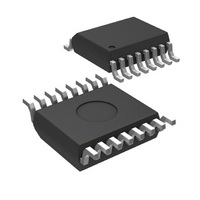MIC916YQS TR Micrel Inc, MIC916YQS TR Datasheet - Page 11

MIC916YQS TR
Manufacturer Part Number
MIC916YQS TR
Description
Triple, 135MHz, 2.4mA Op Amp -
Manufacturer
Micrel Inc
Datasheet
1.MIC916YQS_TR.pdf
(12 pages)
Specifications of MIC916YQS TR
Amplifier Type
Voltage Feedback
Number Of Circuits
3
Slew Rate
270 V/µs
Gain Bandwidth Product
135MHz
-3db Bandwidth
192MHz
Current - Input Bias
3.5µA
Voltage - Input Offset
1000µV
Current - Supply
2.5mA
Current - Output / Channel
90mA
Voltage - Supply, Single/dual (±)
±2.5 V ~ 9 V
Operating Temperature
-40°C ~ 85°C
Mounting Type
Surface Mount
Package / Case
16-QSOP
Lead Free Status / RoHS Status
Lead free / RoHS Compliant
Output Type
-
Lead Free Status / RoHS Status
Lead free / RoHS Compliant
Other names
MIC916YQSTR
MIC916YQSTR
MIC916YQSTR
Applications Information
The MIC916 is a high-speed, voltage-feedback operational
amplifier featuring very low supply current and excellent
stability. This device is unity gain stable and capable of
driving high capacitance loads.
Driving High Capacitance
The MIC916 is stable when driving any capacitance (see
“Typical Characteristics: Gain Bandwidth and Phase Margin
vs. Load Capacitance”) making it ideal for driving long coaxial
cables or other high-capacitance loads.
Phase margin remains constant as load capacitance is
increased. Most high-speed op amps are only able to drive
limited capacitance.
Feedback Resistor Selection
Conventional op amp gain configurations and resistor selec-
tion apply, the MIC916 is NOT a current feedback device.
Resistor values in the range of 1k to 10k are recommended.
Layout Considerations
All high speed devices require careful PCB layout. The high
stability and high PSRR of the MIC916 make this op amp
easier to use than most, but the following guidelines should
be observed: Capacitance, particularly on the two inputs pins
will degrade performance; avoid large copper traces to the
inputs. Keep the output signal away from the inputs and use
a ground plane.
It is important to ensure adequate supply bypassing capaci-
tors are located close to the device.
April 2005
MIC916
Note: increasing load capacitance does reduce the
speed of the device (see “Typical Characteris-
tics: Gain Bandwidth and Phase Margin vs.
Load”). In applications where the load capaci-
tance reduces the speed of the op amp to an
unacceptable level, the effect of the load capaci-
tance can be reduced by adding a small resistor
(<100Ω) in series with the output.
11
Power Supply Bypassing
Regular supply bypassing techniques are recommended. A
10µF capacitor in parallel with a 0.1µF capacitor on both the
positive and negative supplies are ideal. For best perfor-
mance all bypassing capacitors should be located as close to
the op amp as possible and all capacitors should be low ESL
(equivalent series inductance), ESR (equivalent series resis-
tance). Surface-mount ceramic capacitors are ideal. All V–
pins must be externally shorted together.
Thermal Considerations
It is important to ensure the IC does not exceed the maximum
operating junction (die) temperature of 85°C. The part can be
operated up to the absolute maximum temperature rating of
125°C, but between 85°C and 125°C performance will de-
grade, in particular CMRR will reduce.
A MIC916 with no load, dissipates power equal to the quies-
cent supply current * supply voltage
When a load is added, the additional power is dissipated in
the output stage of the op amp. The power dissipated in the
device is a function of supply voltage, output voltage and
output current.
Ensure the total power dissipated in the device is no greater
than the thermal capacity of the package. The QSOP-16
package has a thermal resistance of 260°C/W.
Total Power Dissipation P
P
P
Max Allowable Power Dissipation
D
D
(no load)
(output stage)
.
=
(
V
V
=
+
(
V
−
V
V
+
V
−
−
)
V
I
S
OUT
=
D
(no load)
)
I
OUT
=
T
J
+
(max)
P
D
(outpu stage)
TBD
M9999-042205
−
Micrel, Inc.
T
A
t
(max)
W



